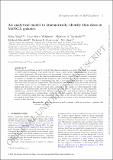Files in this item
An analytical model to kinematically identify thin discs in MaNGA galaxies
Item metadata
| dc.contributor.author | Yang, Meng | |
| dc.contributor.author | Weijmans, Anne-Marie | |
| dc.contributor.author | Bershady, Matthew A. | |
| dc.contributor.author | Merrifield, Michael | |
| dc.contributor.author | Boardman, Nicholas F. | |
| dc.contributor.author | Drory, Niv | |
| dc.date.accessioned | 2021-04-22T11:30:20Z | |
| dc.date.available | 2021-04-22T11:30:20Z | |
| dc.date.issued | 2021-06 | |
| dc.identifier | 273914608 | |
| dc.identifier | feb28681-f7c8-4085-a8ba-19d125dacbda | |
| dc.identifier | 000659453800075 | |
| dc.identifier | 85107923304 | |
| dc.identifier.citation | Yang , M , Weijmans , A-M , Bershady , M A , Merrifield , M , Boardman , N F & Drory , N 2021 , ' An analytical model to kinematically identify thin discs in MaNGA galaxies ' , Monthly Notices of the Royal Astronomical Society , vol. 504 , no. 2 , pp. 2658–2669 . https://doi.org/10.1093/mnras/stab1049 | en |
| dc.identifier.issn | 0035-8711 | |
| dc.identifier.other | BibCode: 2021arXiv210407863Y | |
| dc.identifier.other | ORCID: /0000-0002-5908-6852/work/92775320 | |
| dc.identifier.uri | https://hdl.handle.net/10023/23076 | |
| dc.description | Funding: MY gratefully acknowledges the financial support from China Scholarship Council (CSC). MAB acknowledges support from NSF/AST-1517006. | en |
| dc.description.abstract | We present an analytical model to identify thin discs in galaxies, and apply this model to a sample of SDSS MaNGA galaxies. This model fits the velocity and velocity dispersion fields of galaxies with regular kinematics. By introducing two parameters ζ related to the comparison of the model’s asymmetric drift correction to the observed gas kinematics and η related to the dominant component of a galaxy, we classify the galaxies in the sample as ”disc-dominated”, ”non-disc-dominated”, or ”disc-free” indicating galaxies with a dominating thin disc, a non-dominating thin disc, or no thin disc detection with our method, respectively. The dynamical mass resulting from our model correlates with stellar mass, and we investigate discrepancies by including gas mass and variation of the initial mass function. As expected, most spiral galaxies in the sample are disc-dominated, while ellipticals are predominantly disc-free. Lenticular galaxies show a dichotomy in their kinematic classification, which is related to their different star formation rates and gas fractions. We propose two possible scenarios to explain these results. In the first scenario, disc-free lenticulars formed in more violent processes than disc-dominated ones, while in the second scenario, the quenching processes in lenticulars lead to a change in their kinematic structures as disc-dominated lenticulars evolve to disc-free ones. | |
| dc.format.extent | 2069347 | |
| dc.language.iso | eng | |
| dc.relation.ispartof | Monthly Notices of the Royal Astronomical Society | en |
| dc.subject | Galaxies:kinematics and dynamics | en |
| dc.subject | Galaxies: structure | en |
| dc.subject | Galaxies: disc | en |
| dc.subject | Galaxies: evolution | en |
| dc.subject | QB Astronomy | en |
| dc.subject | QC Physics | en |
| dc.subject | DAS | en |
| dc.subject.lcc | QB | en |
| dc.subject.lcc | QC | en |
| dc.title | An analytical model to kinematically identify thin discs in MaNGA galaxies | en |
| dc.type | Journal article | en |
| dc.contributor.institution | University of St Andrews. School of Physics and Astronomy | en |
| dc.contributor.institution | University of St Andrews. Centre for Contemporary Art | en |
| dc.identifier.doi | 10.1093/mnras/stab1049 | |
| dc.description.status | Peer reviewed | en |
| dc.identifier.url | http://adsabs.harvard.edu/abs/2021arXiv210407863Y | en |
This item appears in the following Collection(s)
Items in the St Andrews Research Repository are protected by copyright, with all rights reserved, unless otherwise indicated.

